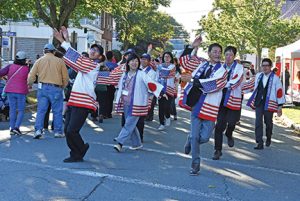
Visitors from Japan lead the goodbye “Tosa” dance on Center Street in front of Fairhaven town hall, at the 17th Manjiro Festival on 10/5/19 in the center of Fairhaven. Fairhaven Neighborhod News file photo by Beth David.
Press Release
Manjiro Nakahama’s story to be celebrated at Japanese festival in Fairhaven on October 7
In 1843, Fairhaven, MA, became the home of the first Japanese person to live in America. The ties of friendship, first formed when a Fairhaven whaling captain rescued fourteen year old Manjiro Nakahama from a small island in the Pacific Ocean, have endured to this day and make Fairhaven a popular spot for visitors from Japan.
On Saturday, October 7, the 18th Manjiro Festival will be held to celebrate the historical ties with Japan and the 36th anniversary of the signing of a Sister City agreement between Fairhaven and Tosashimizu, Japan, the hometown of Manjiro.
The festival will run from 10:00 a.m. to 5:00 p.m. on Center Street between the Town Hall, 40 Center St., and the Millicent Library, 45 Center St. There will be Japanese and American music and food, martial arts demonstrations, taiko drummers, flower arranging, raffles, food and craft booths, a tea ceremony, and much more! Visitors and special guests from Japan will be in attendance. Admission to the festival is free.
Manjiro Festival schedule
• 10-10:30 a.m., classic flute by Takao Shinzawa in town hall, first floor
• 10:30–11 a.m., ukelele by Carolyn Wingate, town hall entrance
• 11–11:30 a.m., official opening with dignitaries, town hall entrance
• 11:30–noon, tea ceremony by Anthony Crasso, town hall, first floor
• 11:30 a.m.–noon, martial arts by Bristol County Aikido, Unitarian church lawn
• Noon–1 p.m. Taiko drumming by Mark H. Taiko, town hall, 2nd floor
• 1–2 p.m. musical band “Interlude, town hall entrance
• 1–1:30 p.m. tea ceremony by Anthony Crasso, town hall, first floor
• 2–3 p.m. flower arranging by Ellen Flynn, town hall, first floor
• 3–4 p.m. Taiko drumming by Mark H. Taiko, town hall, 2nd floor
• 4:30–5 p.m. closing and Tosa dance on Center Street in front of town hall
During the time of the festival the Whitfield-Manjiro Friendship House, 11 Cherry St., will be open to the public, as will the Old Stone Schoolhouse, 40 North Street, where Manjiro attended school when he first arrived in America.
The Manjiro Festival is sponsored by the Whitfield-Manjiro Friendship Society, Inc. For more information email Gerry@WMFriendshipHouse. org or call 508-858-5303. Additional details are posted at http://Whitfield-Manjiro.org.
Manjiro’s Story
Manjiro Nakahama was born in a fishing village in what is now Tosashimizu in 1827. From a poor family, he became a fisherman at the age of thirteen. In early 1841, he and four companions were caught in a storm at sea and shipwrecked on the uninhabited island of Tori Shima (Hurricane Island) in the Pacific. Nearly six months after they had been stranded, the young men were rescued by Fairhaven whaling captain William H. Whitfield aboard the ship John Howland. Manjiro’s four shipmates were set ashore at the Sandwich Islands, but the fourteen-year-old, known to the captain and crew as “John Mung,” chose to return with Whitfield to America.
Manjiro arrived in Fairhaven with Whitfield in May, 1843, Because Whitfield was a widower at the time, he sent Manjiro to live for a short time with the Akin family who lived just down the road from Whitfield’s house until the captain remarried later in the month. Manjiro was tutored by a neighbor, Miss Jane Allen, and he attended classes at the one room Stone Schoolhouse on North Street.
Whitfield bought land on Sconticut Neck and built a farmhouse which was Manjiro’s American home until 1849. During his time in America, Manjiro attended school, studied navigation, and was a crewman on a voyage aboard the whaleship Franklin.
Manjiro left Fairhaven for California during the California Gold Rush. In San Francisco he earned enough money to pay for passage across the Pacific to his homeland. Following his return to Japan, Manjiro became prominent after helping Japanese authorities behind the scenes when Commodore Matthew Perry arrived in Japan in 1853 to negotiate a treaty and trade agreement with Japan. Apparently helping convince the Japanese that a treaty with America would be beneficial, Manjiro later became known as “the man who opened Japan to the West.”
In October of 1870, Manjiro Nakahama revisited the Whitfield family in Fairhaven while on a diplomatic mission to America. The friendship between the two families has endured to this day.
Nearly a century after Manjiro’s death in Japan, the future Emperor of Japan, Crown Prince Akihito, visited Fairhaven in October of 1987 with his wife Princess Michiko. Later in 1987, the Sister City agreement between Fairhaven, MA, and Tosashizu, Japan, was signed. Manjiro Festivals began the following year.
Manjiro Festivals are now held every other year in Fairhaven in odd numbered years and in Japan on even numbered years.
•••
Click here to download the 10/5/23 issue: 10-05-23 GrangeFair
Support local journalism, donate to the Neighb News with PayPal



